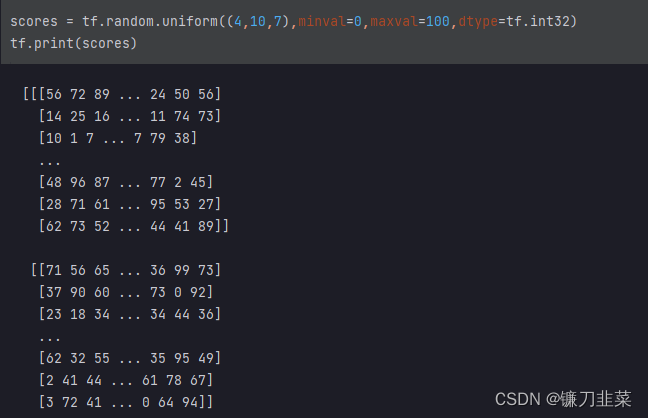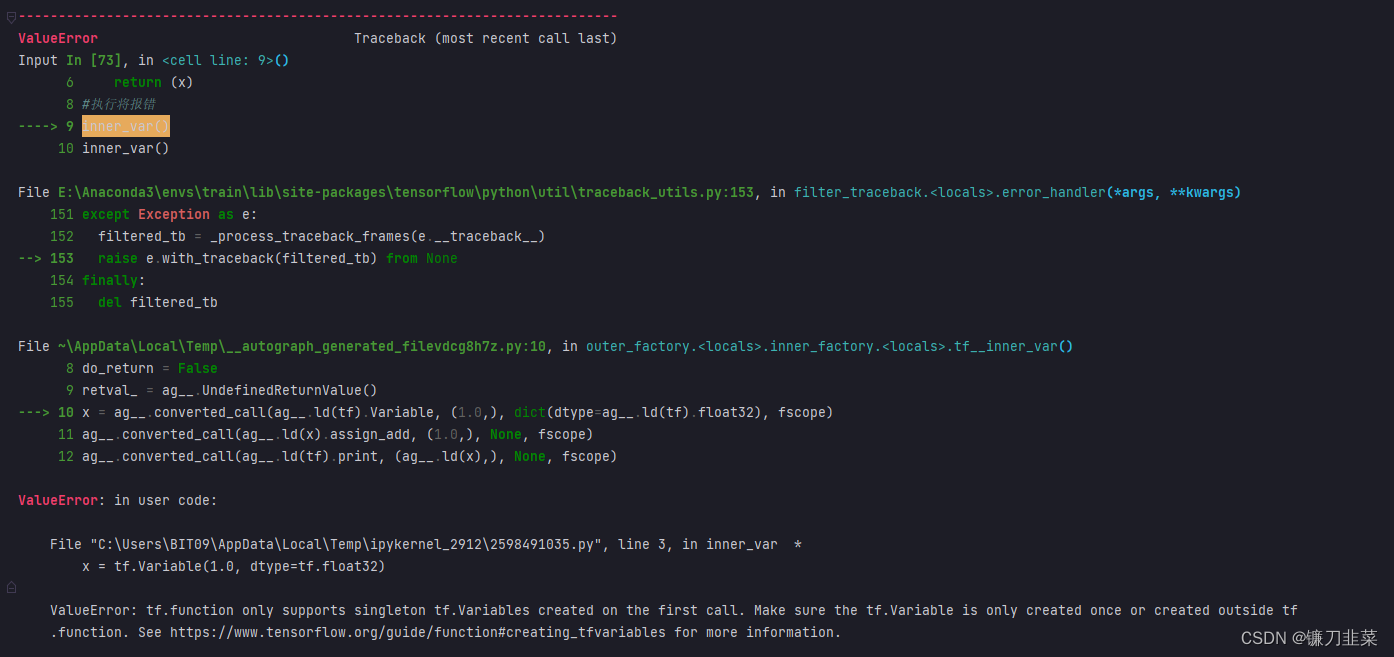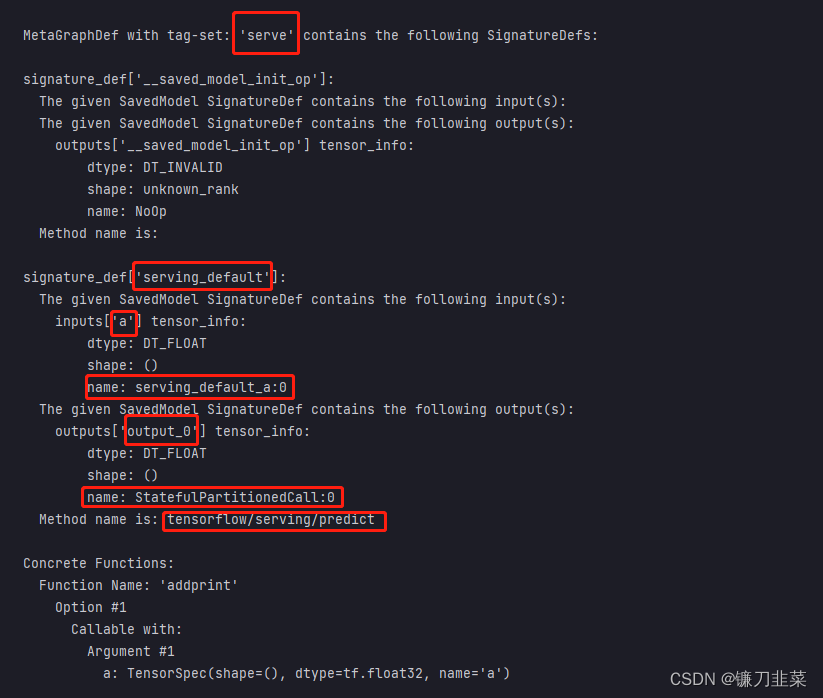TensorFlow2的张量操作与AutoGraph
TensorFlow的低阶API主要包括张量操作,计算图和自动微分。在低阶API层次上,可以把TensorFlow当做一个增强版的numpy来使用。但TensorFlow提供的方法比numpy更全面,运算速度更快,如果需要的话,还可以使用
GPU进行加速。
TensorFlow2的张量操作主要包括张量的结构操作和张量的数学运算:
- 张量结构操作如:张量创建,索引切片,维度变换,合并分割。
- 张量数学运算主要有:标量运算,向量运算,矩阵运算。以及张量运算的广播机制。
对于Autograph计算图,将介绍使用Autograph的规范建议,Autograph的机制原理,Autograph和tf.Module。
Tensorflow中的张量操作
创建张量
基础操作:
import numpy as np
import tensorflow as tf
#%%
a = tf.constant([1,2,3],dtype=tf.float32)
tf.print(a)
#%%
b = tf.range(1,10, delta=2)
tf.print(b)
#%%
c = tf.linspace(0.0,2*3.14,100)
tf.print(c)
#%%
d = tf.zeros([3,3])
tf.print(d)
#%%
e = tf.ones([3,3])
f = tf.zeros_like(e, dtype=tf.float32)
tf.print(e)
tf.print(f)
#%%
g = tf.fill([3,2],5)
tf.print(g)
进阶操作:
# 均匀分布随机
tf.random.set_seed(1.0)
a = tf.random.uniform([5], minval=0, maxval=10)
tf.print(a)
#%%
# 正态分布随机
b = tf.random.normal([3,3],mean=0.0, stddev=1.0)
tf.print(b)
#%%
# 正态分布随机,删除2倍方差以外数据重新生成
c = tf.random.truncated_normal((5,5),mean=0.0,stddev=1.0,dtype=tf.float32)
tf.print(c)
#%%
# 特殊矩阵
I = tf.eye(3,3) # 单位矩阵
tf.print(I)
tf.print(' ')
t = tf.linalg.diag([1,2,3]) # 对角矩阵
tf.print(t)
索引与切片
张量的索引切片方式和numpy几乎是一样的。切片时支持缺省参数和省略号。
- 对于
tf.Variable,可以通过索引和切片对部分元素进行修改。 - 对于提取张量的连续子区域,也可以使用
tf.slice。 - 此外,对于不规则的切片提取,可以使用
tf.gather,tf.gather_nd,tf.boolean_mask。 tf.boolean_mask功能最为强大,它可以实现tf.gather,tf.gather_nd的功能,并且tf.boolean_mask还可以实现布尔索引。- 如果要通过修改张量的某些元素得到新的张量,可以使用
tf.where,tf.scatter_nd。
tf.random.set_seed(1234)
t = tf.random.uniform([5,5],minval=0,maxval=10,dtype=tf.int32)
tf.print(t)
#%%
# 第0行
tf.print(t[0])
#%%
# 倒数第一行
tf.print(t[-1])
#%%
# 第1行第3列
tf.print(t[1,3])
tf.print(t[1][3])
#%%
# 第1行至第3行
tf.print(t[1:4,:])
tf.print(tf.slice(t, [1, 0], [3, 5])) # tf.slice(input, begin_vector, size_vector)
#%%
# 第1行至最后一行,第0列到最后一列每隔两列取一列
tf.print(t[1:4, :4:2])
#%%
# 对变量来说,可以使用索引和切片修改部分元素
x = tf.Variable([[1,2],[3,4]], dtype=tf.float32)
x[1,:].assign(tf.constant([0.0,0.0]))
tf.print(x)
#%%
a = tf.random.uniform([3,3,3],minval=0,maxval=10,dtype=tf.int32)
tf.print(a)
#%%
# 省略号可以表示多个冒号
tf.print(a[...,1])
以上切片方式相对规则,对于不规则的切片提取,可以使用tf.gather,tf.gather_nd,tf.boolean_mask。
示例:考虑班级成绩册的例子,有4个班级,每个班级10个学生,每个学生7门科目成绩。可以用一个4×10×7的张量来表示。

抽取每个班级第0个学生,第5个学生,第9个学生的第1门课程,第3门课程,第6门课程成绩:
q = tf.gather(tf.gather(scores,[0,5,9],axis=1),[1,3,6],axis=2)
tf.print(q)
抽取第0个班级第0个学生,第2个班级的第4个学生,第3个班级的第6个学生的全部成绩:
# indices的长度为采样样本的个数,每个元素为采样位置的坐标
s = tf.gather_nd(scores, indices=[(0,0),(2,4),(3,6)])
tf.print(s)
'''
[[56 72 89 ... 24 50 56]
[25 69 37 ... 71 60 16]
[31 93 50 ... 41 71 59]]
'''
以上tf.gather和tf.gather_nd的功能也可以用tf.boolean_mask来实现。抽取每个班级第0个学生,第5个学生,第9个学生的全部成绩:
p = tf.boolean_mask(scores, [True,False,False,False,False,True,False,False,False,True],axis=1)
tf.print(p)
'''
[[[56 72 89 ... 24 50 56]
[23 96 38 ... 63 54 41]
[62 73 52 ... 44 41 89]]
[[71 56 65 ... 36 99 73]
[85 81 30 ... 14 80 3]
[3 72 41 ... 0 64 94]]
[[1 25 83 ... 2 20 6]
[61 88 85 ... 42 3 45]
[69 85 4 ... 60 27 46]]
[[41 38 86 ... 57 94 72]
[17 79 35 ... 73 29 92]
[91 66 55 ... 71 29 9]]]
'''
抽取第0个班级第0个学生,第2个班级的第4个学生,第3个班级的第6个学生的全部成绩:
s = tf.boolean_mask(scores,
[[True,False,False,False,False,False,False,False,False,False],
[False,False,False,False,False,False,False,False,False,False],
[False,False,False,False,True,False,False,False,False,False],
[False,False,False,False,False,False,True,False,False,False]])
tf.print(s)
'''
[[56 72 89 ... 24 50 56]
[25 69 37 ... 71 60 16]
[31 93 50 ... 41 71 59]]
'''
利用tf.boolean_mask可以实现布尔索引:
# 找到矩阵中小于0的元素
c = tf.constant([[-1,1,-1],[2,2,-2],[3,-3,3]],dtype=tf.float32)
tf.print(c,"\n")
tf.print(tf.boolean_mask(c,c<0),'\n')
tf.print(c[c<0]) # 布尔索引,为boolean_mask的语法糖形式
'''
[[-1 1 -1]
[2 2 -2]
[3 -3 3]]
[-1 -1 -2 -3]
[-1 -1 -2 -3]
'''
以上这些方法仅能提取张量的部分元素值,但不能更改张量的部分元素值得到新的张量。
如果要通过修改张量的部分元素值得到新的张量,可以使用tf.where和tf.scatter_nd。
tf.where可以理解为if的张量版本,此外它还可以用于找到满足条件的所有元素的位置坐标。tf.scatter_nd的作用和tf.gather_nd有些相反,tf.gather_nd用于收集张量的给定位置的元素,而tf.scatter_nd可以将某些值插入到一个给定shape的全0的张量的指定位置处。
找到张量中小于0的元素,将其换成np.nan得到新的张量:
# tf.where和np.where作用类似,可以理解为if的张量版本
c = tf.constant([[-1, 1, -1],[2, 2, -2],[3, -3, 3]], dtype=tf.float32)
d = tf.where(c<0, tf.fill(c.shape, np.nan), c)
d
'''
<tf.Tensor: shape=(3, 3), dtype=float32, numpy=
array([[nan, 1., nan],
[ 2., 2., nan],
[ 3., nan, 3.]], dtype=float32)>
'''
如果where只有一个参数,将返回所有满足条件的位置坐标:
indices = tf.where(c<0)
indices
'''
<tf.Tensor: shape=(4, 2), dtype=int64, numpy=
array([[0, 0],
[0, 2],
[1, 2],
[2, 1]], dtype=int64)>
'''
将张量的第[0, 0]和[2, 1]两个位置元素替换为0得到新的张量:
d = c - tf.scatter_nd([[0,0],[2,1]],[c[0,0],c[2,1]],c.shape)
d
'''
<tf.Tensor: shape=(3, 3), dtype=float32, numpy=
array([[ 0., 1., -1.],
[ 2., 2., -2.],
[ 3., 0., 3.]], dtype=float32)>
'''
scatter_nd的作用和gather_nd有些相反,可以将某些值插入到一个给定shape的全0的张量的指定位置处。
indices = tf.where(c<0)
tf.scatter_nd(indices,tf.gather_nd(c,indices),c.shape)
'''
<tf.Tensor: shape=(3, 3), dtype=float32, numpy=
array([[-1., 0., -1.],
[ 0., 0., -2.],
[ 0., -3., 0.]], dtype=float32)>
'''
维度变换
维度变换相关函数主要有tf.reshape, tf.squeeze, tf.expand_dims, tf.transpose。
tf.reshape可以改变张量的形状。tf.squeeze可以减少维度。tf.expand_dims可以增加维度。tf.transpose可以交换维度。
tf.reshape可以改变张量的形状,但是其本质上不会改变张量元素的存储顺序,所以,该操作实际上非常迅速,并且是可逆的。
a = tf.random.uniform(shape=[1,3,3,2], minval=0, maxval=255, dtype=tf.int32)
tf.print(a.shape)
tf.print(a)
'''
TensorShape([1, 3, 3, 2])
[[[[61 192]
[123 134]
[8 141]]
[[223 19]
[180 0]
[236 153]]
[[154 0]
[146 15]
[120 201]]]]
'''
改成(3,6)形状的张量:
b = tf.reshape(a,[3,6])
tf.print(b.shape)
tf.print(b)
'''
TensorShape([3, 6])
[[61 192 123 134 8 141]
[223 19 180 0 236 153]
[154 0 146 15 120 201]]
'''
改回 [1,3,3,2] 形状的张量:
c = tf.reshape(b,[1,3,3,2])
tf.print(c)
如果张量在某个维度上只有一个元素,利用tf.squeeze可以消除这个维度,和tf.reshape相似,它本质上不会改变张量元素的存储顺序。
张量的各个元素在内存中是线性存储的,其一般规律是,同一层级中的相邻元素的物理地址也相邻。
s = tf.squeeze(a)
tf.print(s.shape)
tf.print(s)
'''
TensorShape([3, 3, 2])
[[[61 192]
[123 134]
[8 141]]
[[223 19]
[180 0]
[236 153]]
[[154 0]
[146 15]
[120 201]]]
'''
在第0维插入长度为1的一个维度:
d = tf.expand_dims(s, axis=0)
d
'''
<tf.Tensor: shape=(1, 3, 3, 2), dtype=int32, numpy=
array([[[[ 61, 192],
[123, 134],
[ 8, 141]],
[[223, 19],
[180, 0],
[236, 153]],
[[154, 0],
[146, 15],
[120, 201]]]])>
'''
tf.transpose可以交换张量的维度,与tf.reshape不同,它会改变张量元素的存储顺序。tf.transpose常用于图片存储格式的变换上。
# Batch,Height,Width,Channel
a = tf.random.uniform(shape=[100,600,600,4],minval=0,maxval=255,dtype=tf.int32)
tf.print(a.shape)
# 转换成 Channel,Height,Width,Batch
s= tf.transpose(a,perm=[3,1,2,0])
tf.print(s.shape)
'''
TensorShape([100, 600, 600, 4])
TensorShape([4, 600, 600, 100])
'''
分割与合并
和numpy类似,可以用tf.concat和tf.stack方法对多个张量进行合并,可以用tf.split方法把一个张量分割成多个张量。
注意:tf.concat和tf.stack有略微的区别,tf.concat是连接,不会增加维度,而tf.stack是堆叠,会增加维度。
a = tf.constant([[1.0,2.0],[3.0,4.0]])
b = tf.constant([[5.0,6.0],[7.0,8.0]])
c = tf.constant([[9.0,10.0],[11.0,12.0]])
tf.concat([a,b,c],axis = 0)
'''
<tf.Tensor: shape=(6, 2), dtype=float32, numpy=
array([[ 1., 2.],
[ 3., 4.],
[ 5., 6.],
[ 7., 8.],
[ 9., 10.],
[11., 12.]], dtype=float32)>
'''
tf.concat([a, b, c],axis = 1)
'''
<tf.Tensor: shape=(2, 6), dtype=float32, numpy=
array([[ 1., 2., 5., 6., 9., 10.],
[ 3., 4., 7., 8., 11., 12.]], dtype=float32)>
'''
tf.stack([a,b,c])
'''
<tf.Tensor: shape=(3, 2, 2), dtype=float32, numpy=
array([[[ 1., 2.],
[ 3., 4.]],
[[ 5., 6.],
[ 7., 8.]],
[[ 9., 10.],
[11., 12.]]], dtype=float32)>
'''
tf.stack([a,b,c], axis=1)
'''
<tf.Tensor: shape=(2, 3, 2), dtype=float32, numpy=
array([[[ 1., 2.],
[ 5., 6.],
[ 9., 10.]],
[[ 3., 4.],
[ 7., 8.],
[11., 12.]]], dtype=float32)>
'''
tf.split是tf.concat的逆运算,可以指定分割份数平均分割,也可以通过指定每份的记录数量进行分割。
#tf.split(value,num_or_size_splits,axis)
tf.split(c, 3, axis = 0) #指定分割份数,平均分割
'''
[<tf.Tensor: shape=(2, 2), dtype=float32, numpy=
array([[1., 2.],
[3., 4.]], dtype=float32)>,
<tf.Tensor: shape=(2, 2), dtype=float32, numpy=
array([[5., 6.],
[7., 8.]], dtype=float32)>,
<tf.Tensor: shape=(2, 2), dtype=float32, numpy=
array([[ 9., 10.],
[11., 12.]], dtype=float32)>]
'''
tf.split(c,[2, 2, 2], axis = 0) #指定每份的记录数量
'''
[<tf.Tensor: shape=(2, 2), dtype=float32, numpy=
array([[1., 2.],
[3., 4.]], dtype=float32)>,
<tf.Tensor: shape=(2, 2), dtype=float32, numpy=
array([[5., 6.],
[7., 8.]], dtype=float32)>,
<tf.Tensor: shape=(2, 2), dtype=float32, numpy=
array([[ 9., 10.],
[11., 12.]], dtype=float32)>]
'''
Tensorflow中的数学运算
张量的数学运算符可以分为标量运算符、向量运算符、以及矩阵运算符。
标量运算
- 加减乘除乘方,以及三角函数,指数,对数等常见函数,逻辑比较运算符等都是标量运算符。
- 标量运算符的特点是对张量实施逐元素运算。
- 有些标量运算符对常用的数学运算符进行了重载。并且支持类似numpy的广播特性。
- 许多标量运算符都在
tf.math模块下。
import tensorflow as tf
import numpy as np
标量运算:
a = tf.constant([[1.0,2],[-3,4.0]])
b = tf.constant([[5.0,6],[7.0,8.0]])
a + b #运算符重载
'''
<tf.Tensor: shape=(2, 2), dtype=float32, numpy=
array([[ 6., 8.],
[ 4., 12.]], dtype=float32)>
'''
a-b
'''
<tf.Tensor: shape=(2, 2), dtype=float32, numpy=
array([[ -4., -4.],
[-10., -4.]], dtype=float32)>
'''
a*b
'''
<tf.Tensor: shape=(2, 2), dtype=float32, numpy=
array([[ 5., 12.],
[-21., 32.]], dtype=float32)>
'''
a/b
'''
<tf.Tensor: shape=(2, 2), dtype=float32, numpy=
array([[ 0.2 , 0.33333334],
[-0.42857143, 0.5 ]], dtype=float32)>
'''
a**2
'''
<tf.Tensor: shape=(2, 2), dtype=float32, numpy=
array([[ 1., 4.],
[ 9., 16.]], dtype=float32)>
'''
a**(0.5)
'''
<tf.Tensor: shape=(2, 2), dtype=float32, numpy=
array([[1. , 1.4142135],
[ nan, 2. ]], dtype=float32)>
'''
a%3 #mod的运算符重载,等价于m = tf.math.mod(a,3)
'''
<tf.Tensor: shape=(3,), dtype=int32, numpy=array([1, 2, 0], dtype=int32)>
'''
a//3 #地板除法
'''
<tf.Tensor: shape=(2, 2), dtype=float32, numpy=
array([[ 0., 0.],
[-1., 1.]], dtype=float32)>
'''
(a>=2) # 逻辑运算符
'''
<tf.Tensor: shape=(2, 2), dtype=bool, numpy=
array([[False, True],
[False, True]])>
'''
(a>=2)&(a<=3)
'''
<tf.Tensor: shape=(2, 2), dtype=bool, numpy=
array([[False, True],
[False, False]])>
'''
(a>=2)|(a<=3)
'''
<tf.Tensor: shape=(2, 2), dtype=bool, numpy=
array([[ True, True],
[ True, True]])>
'''
a==5 #tf.equal(a,5)
'''
<tf.Tensor: shape=(3,), dtype=bool, numpy=array([False, False, False])>
'''
tf.sqrt(a)
'''
<tf.Tensor: shape=(2, 2), dtype=float32, numpy=
array([[1. , 1.4142135],
[ nan, 2. ]], dtype=float32)>
'''
a = tf.constant([1.0,8.0])
b = tf.constant([5.0,6.0])
c = tf.constant([6.0,7.0])
tf.add_n([a,b,c]) # 元素逐位置相加
'''
<tf.Tensor: shape=(2,), dtype=float32, numpy=array([12., 21.], dtype=float32)>
'''
tf.print(tf.maximum(a,b))
'''
[5 8]
'''
tf.print(tf.minimum(a,b))
'''
[1 6]
'''
x = tf.constant([2.6,-2.7])
tf.print(tf.math.round(x)) #保留整数部分,四舍五入
tf.print(tf.math.floor(x)) #保留整数部分,向下归整
tf.print(tf.math.ceil(x)) #保留整数部分,向上归整
'''
[3 -3]
[2 -3]
[3 -2]
'''
# 幅值裁剪
x = tf.constant([0.9,-0.8,100.0,-20.0,0.7])
y = tf.clip_by_value(x,clip_value_min=-1,clip_value_max=1)
z = tf.clip_by_norm(x,clip_norm = 3)
tf.print(y)
tf.print(z)
'''
[0.9 -0.8 1 -1 0.7]
[0.0264732055 -0.0235317405 2.94146752 -0.588293493 0.0205902718]
'''
向量运算
向量运算符只在一个特定轴上运算,将一个向量映射到一个标量或者另外一个向量。许多向量运算符都以reduce开头。
(1)向量reduce
a = tf.range(1, 10)
tf.print(a)
tf.print(tf.reduce_sum(a))
tf.print(tf.reduce_mean(a))
tf.print(tf.reduce_max(a))
tf.print(tf.reduce_min(a))
tf.print(tf.reduce_prod(a))
'''
[1 2 3 ... 7 8 9]
45
5
9
1
362880
'''
(2)张量指定维度进行reduce
b = tf.reshape(a, (3, 3))
tf.print(b)
tf.print(tf.reduce_sum(b, axis=1, keepdims=True))
tf.print(tf.reduce_sum(b, axis=0, keepdims=True))
'''
[[1 2 3]
[4 5 6]
[7 8 9]]
[[6]
[15]
[24]]
[[12 15 18]]
'''
(3)bool类型的reduce
p = tf.constant([True,False,False])
q = tf.constant([False,False,True])
tf.print(tf.reduce_all(p)) # 0
tf.print(tf.reduce_any(q)) # 1
(4)利用tf.foldr实现tf.reduce_sum
s = tf.foldr(lambda a,b:a+b,tf.range(10))
tf.print(s) # 45
(5)cum扫描累积
a = tf.range(1,10)
tf.print(tf.math.cumsum(a))
tf.print(tf.math.cumprod(a))
'''
[1 3 6 ... 28 36 45]
[1 2 6 ... 5040 40320 362880]
'''
(6)arg最大最小值索引
a = tf.range(1,10)
tf.print(tf.argmax(a)) # 8
tf.print(tf.argmin(a)) # 0
(7)tf.math.top_k可以用于对张量排序
a = tf.constant([1,3,7,5,4,8])
values,indices = tf.math.top_k(a,3,sorted=True)
tf.print(values)
tf.print(indices)
#利用tf.math.top_k可以在TensorFlow中实现KNN算法
'''
[8 7 5]
[5 2 3]
'''
矩阵运算
- 矩阵必须是二维的。类似
tf.constant([1,2,3])这样的不是矩阵。 - 矩阵运算包括:矩阵
乘法,矩阵转置,矩阵逆,矩阵求迹,矩阵范数,矩阵行列式,矩阵求特征值,矩阵分解等运算。 - 除了一些常用的运算外,大部分和矩阵有关的运算都在
tf.linalg子包中。
# 矩阵乘法
a = tf.constant([[1,2],[3,4]])
b = tf.constant([[2,0],[0,2]])
a@b #等价于tf.matmul(a,b)
'''
<tf.Tensor: shape=(2, 2), dtype=int32, numpy=
array([[2, 4],
[6, 8]], dtype=int32)>
'''
# 矩阵转置
a = tf.constant([[1,2],[3,4]])
tf.transpose(a)
'''
<tf.Tensor: shape=(2, 2), dtype=int32, numpy=
array([[1, 3],
[2, 4]], dtype=int32)>
'''
# 矩阵逆,必须为tf.float32或tf.double类型
a = tf.constant([[1.0,2],[3,4]],dtype = tf.float32)
tf.linalg.inv(a)
'''
<tf.Tensor: shape=(2, 2), dtype=float32, numpy=
array([[-2.0000002 , 1.0000001 ],
[ 1.5000001 , -0.50000006]], dtype=float32)>
'''
# 矩阵求trace
a = tf.constant([[1.0,2],[3,4]],dtype = tf.float32)
tf.linalg.trace(a)
'''
<tf.Tensor: shape=(), dtype=float32, numpy=5.0>
'''
# 矩阵求范数
a = tf.constant([[1.0,2],[3,4]])
tf.linalg.norm(a)
'''
<tf.Tensor: shape=(), dtype=float32, numpy=5.477226>
'''
# 矩阵行列式
a = tf.constant([[1.0,2],[3,4]])
tf.linalg.det(a)
'''
<tf.Tensor: shape=(), dtype=float32, numpy=-2.0>
'''
# 矩阵特征值
a = tf.constant([[1.0,2],[-5,4]])
tf.linalg.eigvals(a)
'''
<tf.Tensor: shape=(2,), dtype=complex64, numpy=array([2.4999995+2.7838817j, 2.5 -2.783882j ], dtype=complex64)>
'''
矩阵QR分解, 将一个方阵分解为一个正交矩阵q和上三角矩阵r:
# QR分解实际上是对矩阵a实施Schmidt正交化得到q
a = tf.constant([[1.0, 2.0], [3.0, 4.0]], dtype=tf.float32)
q, r = tf.linalg.qr(a)
tf.print(q)
tf.print(r)
tf.print(q @ r)
'''
[[-0.316227794 -0.948683321]
[-0.948683321 0.316227734]]
[[-3.1622777 -4.4271884]
[0 -0.632455349]]
[[1.00000012 1.99999976]
[3 4]]
'''
矩阵SVD分解:
#svd分解可以将任意一个矩阵分解为一个正交矩阵u,一个对角阵s和一个正交矩阵v.t()的乘积
#svd常用于矩阵压缩和降维
a = tf.constant([[1.0,2.0],[3.0,4.0],[5.0,6.0]], dtype = tf.float32)
s,u,v = tf.linalg.svd(a)
tf.print(u,"\n")
tf.print(s,"\n")
tf.print(v,"\n")
tf.print(u@tf.linalg.diag(s)@tf.transpose(v))
#利用svd分解可以在TensorFlow中实现主成分分析降维
'''
[[-0.229847893 0.883461297]
[-0.524744868 0.240781844]
[-0.819642 -0.401895821]]
[9.52551937 0.514301538]
[[-0.619629383 -0.784894526]
[-0.784894526 0.619629383]]
[[1.00000024 2.00000238]
[3.00000024 4.00000143]
[5.00000048 6.00000143]]
'''
广播机制
TensorFlow的广播规则和numpy是一样的:
- 如果张量的维度不同,将维度较小的张量进行扩展,直到两个张量的维度都一样。
- 如果两个张量在某个维度上的长度是相同的,或者其中一个张量在该维度上的长度为1,那么我们就说这两个张量在该维度上是相容的。
- 如果两个张量在所有维度上都是相容的,它们就能使用广播。
- 广播之后,每个维度的长度将取两个张量在该维度长度的较大值。
- 在任何一个维度上,如果一个张量的长度为1,另一个张量长度大于1,那么在该维度上,就好像是对第一个张量进行了复制。
tf.broadcast_to以显式的方式按照广播机制扩展张量的维度。
a = tf.constant([1,2,3])
b = tf.constant([[0,0,0],[1,1,1],[2,2,2]])
b + a #等价于 b + tf.broadcast_to(a,b.shape)
'''
<tf.Tensor: shape=(3, 3), dtype=int32, numpy=
array([[1, 2, 3],
[2, 3, 4],
[3, 4, 5]], dtype=int32)>
'''
tf.broadcast_to(a,b.shape)
'''
<tf.Tensor: shape=(3, 3), dtype=int32, numpy=
array([[1, 2, 3],
[1, 2, 3],
[1, 2, 3]], dtype=int32)>
'''
计算广播后计算结果的形状,静态形状,TensorShape类型参数:
tf.broadcast_static_shape(a.shape,b.shape)
'''
TensorShape([3, 3])
'''
计算广播后计算结果的形状,动态形状,Tensor类型参数
c = tf.constant([1,2,3])
d = tf.constant([[1],[2],[3]])
tf.broadcast_dynamic_shape(tf.shape(c),tf.shape(d))
'''
<tf.Tensor: shape=(2,), dtype=int32, numpy=array([3, 3], dtype=int32)>
'''
广播效果:
c+d #等价于 tf.broadcast_to(c,[3,3]) + tf.broadcast_to(d,[3,3])
'''
<tf.Tensor: shape=(3, 3), dtype=int32, numpy=
array([[2, 3, 4],
[3, 4, 5],
[4, 5, 6]], dtype=int32)>
'''
Tensorflow中的AutoGraph计算图
AutoGraph的使用规范
目前,有三种计算图的构建方式:静态计算图,动态计算图,以及Autograph。TensorFlow 2.0主要使用的是动态计算图和Autograph。
- 动态计算图易于调试,编码效率较高,但执行效率偏低。
- 静态计算图执行效率很高,但较难调试。
- Autograph机制可以将动态图转换成静态计算图,同时具有执行效率和编码效率的优势。
当然Autograph机制能够转换的代码并不是没有任何约束的,有一些编码规范需要遵循,否则可能会转换失败或者不符合预期。接下来介绍Autograph的编码规范和Autograph转换成静态图的原理,并介绍使用tf.Module来更好地构建Autograph。
Autograph编码规范
- 被
@tf.function修饰的函数应尽可能使用TensorFlow中的函数而不是Python中的其他函数。例如使用tf.print而不是print,使用tf.range而不是range,使用tf.constant(True)而不是True. - 避免在
@tf.function修饰的函数内部定义tf.Variable. - 被
@tf.function修饰的函数不可修改该函数外部的Python列表或字典等数据结构变量。
Autograph编码示例
- 被@tf.function修饰的函数应尽量使用TensorFlow中的函数而不是Python中的其他函数。
import numpy as np
import tensorflow as tf
@tf.function
def np_random():
a = np.random.randn(3,3)
tf.print(a)
@tf.function
def tf_random():
a = tf.random.normal((3,3))
tf.print(a)
np_random每次执行都是一样的结果:
np_random()
np_random()
'''
array([[ 0.50224647, -0.15924273, 0.727995 ],
[-0.37840825, -1.00053087, -0.78702307],
[ 1.26153662, 1.64081248, -1.57451626]])
array([[ 0.50224647, -0.15924273, 0.727995 ],
[-0.37840825, -1.00053087, -0.78702307],
[ 1.26153662, 1.64081248, -1.57451626]])
'''
tf_random每次执行都会有重新生成随机数:
tf_random()
tf_random()
'''
[[-0.302002043 1.99549484 -1.43466115]
[-2.59828162 0.0505513214 -0.533689559]
[-0.0854836 1.53205907 0.352520168]]
[[-1.49828815 1.54806888 1.26572335]
[2.20143676 -0.256682128 -0.273425788]
[-0.0966404602 -0.248796791 -0.629100084]]
'''
- 避免在@tf.function修饰的函数内部定义tf.Variable.
x = tf.Variable(1.0, dtype=tf.float32)
@tf.function
def outer_var():
x.assign_add(1.0)
tf.print(x)
return (x)
outer_var() # 2
outer_var() # 3
如果在@tf.function修饰的函数内部定义tf.Variable,则将报错:
@tf.function
def inner_var():
x = tf.Variable(1.0, dtype=tf.float32)
x.assign_add(1.0)
tf.print(x)
return x
#执行将报错
inner_var()
inner_var()

- 被@tf.function修饰的函数不可修改该函数外部的Python列表或字典等结构类型变量。
tensor_list = []
#@tf.function #加上这一行切换成Autograph结果将不符合预期!!!
def append_tensor(x):
tensor_list.append(x)
return tensor_list
append_tensor(tf.constant(5.0))
append_tensor(tf.constant(6.0))
print(tensor_list)
'''
[<tf.Tensor: shape=(), dtype=float32, numpy=5.0>, <tf.Tensor: shape=(), dtype=float32, numpy=6.0>]
'''
tensor_list = []
@tf.function #加上这一行切换成Autograph结果将不符合预期!!!
def append_tensor(x):
tensor_list.append(x)
return tensor_list
append_tensor(tf.constant(5.0))
append_tensor(tf.constant(6.0))
print(tensor_list)
'''
[<tf.Tensor 'x:0' shape=() dtype=float32>]
'''
AutoGraph的机制原理
当使用@tf.function装饰一个函数的时候,后面到底发生了什么呢?
import tensorflow as tf
import numpy as np
@tf.function(autograph=True)
def myadd(a,b):
for i in tf.range(3):
tf.print(i)
c = a+b
print("tracing")
return c
当我们第一次调用这个被@tf.function装饰的函数时,后面到底发生了什么?
myadd(tf.constant('hello'), tf.constant(' world'))
'''
tracing
0
1
2
'''
发生了2件事情:
①第一件事情是创建计算图,即创建一个静态计算图,跟踪执行一遍函数体中的Python代码,确定各个变量的Tensor类型,并根据执行顺序将算子添加到计算图中。在这个过程中,如果开启了autograph=True(默认开启),会将Python控制流转换成TensorFlow图内控制流。主要是将if语句转换成 tf.cond算子表达,将while和for循环语句转换成tf.while_loop算子表达,并在必要的时候添加tf.control_dependencies指定执行顺序依赖关系。
②第二件事情是执行计算图。因此先看到的是第一个步骤的结果:即Python调用标准输出流打印"tracing"语句。然后看到第二个步骤的结果:TensorFlow调用标准输出流打印0,1,2。
当我们再次用相同的输入参数类型调用这个被@tf.function装饰的函数时,后面到底发生了什么?
0
1
2
只会发生一件事情,那就是上面步骤的第二步,执行计算图。所以这一次没有看到打印"tracing"的结果。
当再次用不同的的输入参数类型调用这个被@tf.function装饰的函数时,后面到底发生了什么?
myadd(tf.constant(1),tf.constant(2))
'''
tracing
0
1
2
'''
由于输入参数的类型已经发生变化,已经创建的计算图不能够再次使用。所以需要重新做2件事情:创建新的计算图、执行计算图。
需要注意的是,如果调用被@tf.function装饰的函数时输入的参数不是Tensor类型,则每次都会重新创建计算图。
myadd("hello","world")
myadd("good","morning")
'''
tracing
0
1
2
tracing
0
1
2
'''
因此,一般建议调用@tf.function时应传入Tensor类型。
AutoGraph的编码规范再理解
-
被@tf.function修饰的函数应尽量使用TensorFlow中的函数而不是Python中的其他函数。例如使用tf.print而不是print。
原因:Python中的函数仅仅会在跟踪执行函数以创建静态图的阶段使用,普通python函数是无法嵌入到静态计算图中的,所以在计算图构建好之后再次调用的时候,这些python函数并没有被计算,而Tensorflow中的函数则可以嵌入到计算图中。所以使用普通的Python函数会导致被@tf.function修饰前(eager执行)和被@tf.function修饰后(静态图执行)的输出不一致。 -
避免在@tf.function修饰的函数内部定义tf.Variable.
原因:如果函数内部定义了tf.Variable,那么在(eager执行)时,这种创建tf.Variable的行为在每次函数调用时候都会发生。但是在静态图执行时,这种创建tf.Variable的行为只会发生在第一步跟踪Python代码逻辑创建计算图时,这会导致被@tf.function修饰前(eager执行)和被@tf.function修饰后(静态图执行)的输出不一致。实际上,TensorFlow在这种情况下一般会报错。 -
被@tf.function修饰的函数不可修改该函数外部的Python列表或字典等数据结构变量。
原因:静态计算图是被编译成C++代码在TensorFlow内核中执行的。Python中的列表和字典等数据结构变量是无法嵌入到计算图中,它们仅仅能够在创建计算图时被读取,因此在执行计算图时是无法修改Python中的列表或字典这样的数据结构变量的。
Tensorflow中的AutoGraph与tf.Module
前面在介绍Autograph的编码规范时提到构建Autograph时应该避免在@tf.function修饰的函数内部定义tf.Variable。但是如果在函数外部定义tf.Variable的话,又会显得这个函数有外部变量依赖,封装不够完美。
- 一种简单的思路是定义一个类,并将相关的tf.Variable创建放在类的初始化方法中,而将函数的逻辑放在其他方法中。
- 另一种方法是TensorFlow提供了一个基类tf.Module,通过继承它构建子类,可以非常方便地管理变量,还可以非常方便地管理它引用的其它Module,最重要的是,能够利用
tf.saved_model保存模型并实现跨平台部署使用。
实际上,tf.keras.models.Model,tf.keras.layers.Layer 都是继承自tf.Module的,提供了方便的变量管理和所引用的子模块管理的功能。因此,利用tf.Module提供的封装,再结合TensoFlow丰富的低阶API,就能够基于TensorFlow开发任意机器学习模型(而非仅仅是神经网络模型),并实现跨平台部署使用。
应用tf.Module封装Autograph
首先定义一个简单的function:
import tensorflow as tf
x = tf.Variable(1.0, dtype=tf.float32)
#在tf.function中用input_signature限定输入张量的签名类型:shape和dtype
@tf.function(input_signature=[tf.TensorSpec(shape=[], dtype=tf.float32)])
def add_print(a):
x.assign_add(a)
tf.print(x)
return x
输入不符合张量签名的参数将报错:
add_print(tf.constant(3.0)) # 4
#add_print(tf.constant(3)) # 将报错
下面利用tf.Module的子类化将其封装一下:
class DemoModule(tf.Module):
def __init__(self, init_value=tf.constant(0.0), name=None):
super(DemoModule, self).__init__(name=name)
with self.name_scope: #相当于with tf.name_scope("demo_module")
self.x = tf.Variable(init_value, dtype=tf.float32, trainable=True)
@tf.function(input_signature=[tf.TensorSpec(shape=[], dtype=tf.float32)])
def addprint(self, a):
with self.name_scope:
self.x.assign_add(a)
tf.print(self.x)
return self.x
demo = DemoModule(init_value=tf.constant(1.0))
result = demo.addprint(tf.constant(5.0))
'''
6
'''
查看模块中的全部变量和全部可训练变量:
print(demo.variables)
print(demo.trainable_variables)
'''
(<tf.Variable 'demo_module/Variable:0' shape=() dtype=float32, numpy=6.0>,)
(<tf.Variable 'demo_module/Variable:0' shape=() dtype=float32, numpy=6.0>,)
'''
查看模块中的全部子模块:
demo.submodules
使用tf.saved_model 保存模型,并指定需要跨平台部署的方法:
tf.saved_model.save(demo,"../DemoData/autograph/1",signatures = {"serving_default":demo.addprint})
加载模型:
demo2 = tf.saved_model.load("../DemoData/autograph/1")
demo2.addprint(tf.constant(5.0))
查看模型文件相关信息,红框标出来的输出信息在模型部署和跨平台使用时有可能会用到:
!saved_model_cli show --dir ../DemoData/autograph/1 --all

除了利用tf.Module的子类化实现封装,也可以通过给tf.Module添加属性的方法进行封装:
mymodule = tf.Module()
mymodule.x = tf.Variable(0.0) # 添加属性
@tf.function(input_signature=[tf.TensorSpec(shape = [], dtype = tf.float32)])
def addprint(a):
mymodule.x.assign_add(a)
tf.print(mymodule.x)
return mymodule.x
mymodule.addprint = addprint
mymodule.addprint(tf.constant(1.0)).numpy() # 1.0
print(mymodule.variables)
'''
(<tf.Variable 'Variable:0' shape=() dtype=float32, numpy=0.0>,)
'''
使用tf.saved_model 保存模型:
tf.saved_model.save(mymodule,"../DemoData/autograph/2",
signatures = {"serving_default":mymodule.addprint})
#加载模型
mymodule2 = tf.saved_model.load("../DemoData/autograph/2")
mymodule2.addprint(tf.constant(5.0))
'''
INFO:tensorflow:Assets written to: ../DemoData/autograph/2\assets
6
'''
tf.Module和tf.keras.Model, tf.keras.layers.Layer的关系
tf.keras中的模型和层都是继承tf.Module实现的,也具有变量管理和子模块管理功能。
import tensorflow as tf
from tensorflow.keras import models,layers,losses,metrics
print(issubclass(tf.keras.Model,tf.Module)) # True
print(issubclass(tf.keras.layers.Layer,tf.Module)) # True
print(issubclass(tf.keras.Model,tf.keras.layers.Layer)) # True
创建模型:
tf.keras.backend.clear_session()
model = models.Sequential()
model.add(layers.Dense(4,input_shape = (10,)))
model.add(layers.Dense(2))
model.add(layers.Dense(1))
model.summary()
'''
Model: "sequential"
_________________________________________________________________
Layer (type) Output Shape Param #
=================================================================
dense (Dense) (None, 4) 44
dense_1 (Dense) (None, 2) 10
dense_2 (Dense) (None, 1) 3
=================================================================
Total params: 57
Trainable params: 57
Non-trainable params: 0
_________________________________________________________________
'''
模型的变量:
model.variables
'''
[<tf.Variable 'dense/kernel:0' shape=(10, 4) dtype=float32, numpy=
array([[ 0.06851107, 0.6222638 , 0.18818557, -0.5624115 ],
[ 0.10263896, -0.5808124 , -0.13333768, -0.01909971],
[ 0.46239233, 0.56399536, 0.5484568 , -0.41919693],
[-0.2521158 , -0.44343483, -0.19948038, -0.1928229 ],
[-0.42875177, -0.24698243, 0.24389917, 0.19735926],
[-0.3121134 , -0.24455473, 0.01878113, -0.36502132],
[-0.51711345, -0.26277727, 0.04020506, -0.5468274 ],
[-0.6365008 , 0.0702194 , -0.49117038, -0.5075959 ],
[-0.09411347, 0.37452304, -0.5319024 , 0.00577706],
[ 0.53566325, 0.15658683, 0.42216563, -0.4886946 ]],
dtype=float32)>,
<tf.Variable 'dense/bias:0' shape=(4,) dtype=float32, numpy=array([0., 0., 0., 0.], dtype=float32)>,
<tf.Variable 'dense_1/kernel:0' shape=(4, 2) dtype=float32, numpy=
array([[-9.6579075e-02, 9.5146084e-01],
[ 9.2552114e-01, -4.6730042e-04],
[-7.0310831e-02, 3.0072451e-01],
[-6.3602138e-01, -6.9972920e-01]], dtype=float32)>,
<tf.Variable 'dense_1/bias:0' shape=(2,) dtype=float32, numpy=array([0., 0.], dtype=float32)>,
<tf.Variable 'dense_2/kernel:0' shape=(2, 1) dtype=float32, numpy=
array([[0.8551854],
[0.5268774]], dtype=float32)>,
<tf.Variable 'dense_2/bias:0' shape=(1,) dtype=float32, numpy=array([0.], dtype=float32)>]
'''
冻结第0层的变量,使其不可训练:
model.layers[0].trainable = False
model.trainable_variables
'''
[<tf.Variable 'dense_1/kernel:0' shape=(4, 2) dtype=float32, numpy=
array([[-9.6579075e-02, 9.5146084e-01],
[ 9.2552114e-01, -4.6730042e-04],
[-7.0310831e-02, 3.0072451e-01],
[-6.3602138e-01, -6.9972920e-01]], dtype=float32)>,
<tf.Variable 'dense_1/bias:0' shape=(2,) dtype=float32, numpy=array([0., 0.], dtype=float32)>,
<tf.Variable 'dense_2/kernel:0' shape=(2, 1) dtype=float32, numpy=
array([[0.8551854],
[0.5268774]], dtype=float32)>,
<tf.Variable 'dense_2/bias:0' shape=(1,) dtype=float32, numpy=array([0.], dtype=float32)>]
'''
模型的子模块:
model.submodules
'''
(<keras.engine.input_layer.InputLayer at 0x2a6cdd4eca0>,
<keras.layers.core.dense.Dense at 0x2a59e510280>,
<keras.layers.core.dense.Dense at 0x2a6cdd4e670>,
<keras.layers.core.dense.Dense at 0x2a6ce9384c0>)
'''
模型的层:
model.layers
'''
[<keras.layers.core.dense.Dense at 0x2a6cdd4e670>,
<keras.layers.core.dense.Dense at 0x2a6ce9384c0>,
<keras.layers.core.dense.Dense at 0x2a59e510280>]
'''
模型的名称及所属范围:
print(model.name) # sequential
print(model.name_scope()) # sequential/
参考资料
[1] 《Tensorflow:实战Google深度学习框架》
[2] 《30天吃掉那只Tensorflow》








 本文详细介绍了TensorFlow2中的张量操作,包括张量创建、索引切片、维度变换、数学运算等内容,并深入探讨了Autograph的工作原理及其与tf.Module的应用。
本文详细介绍了TensorFlow2中的张量操作,包括张量创建、索引切片、维度变换、数学运算等内容,并深入探讨了Autograph的工作原理及其与tf.Module的应用。


















 被折叠的 条评论
为什么被折叠?
被折叠的 条评论
为什么被折叠?










